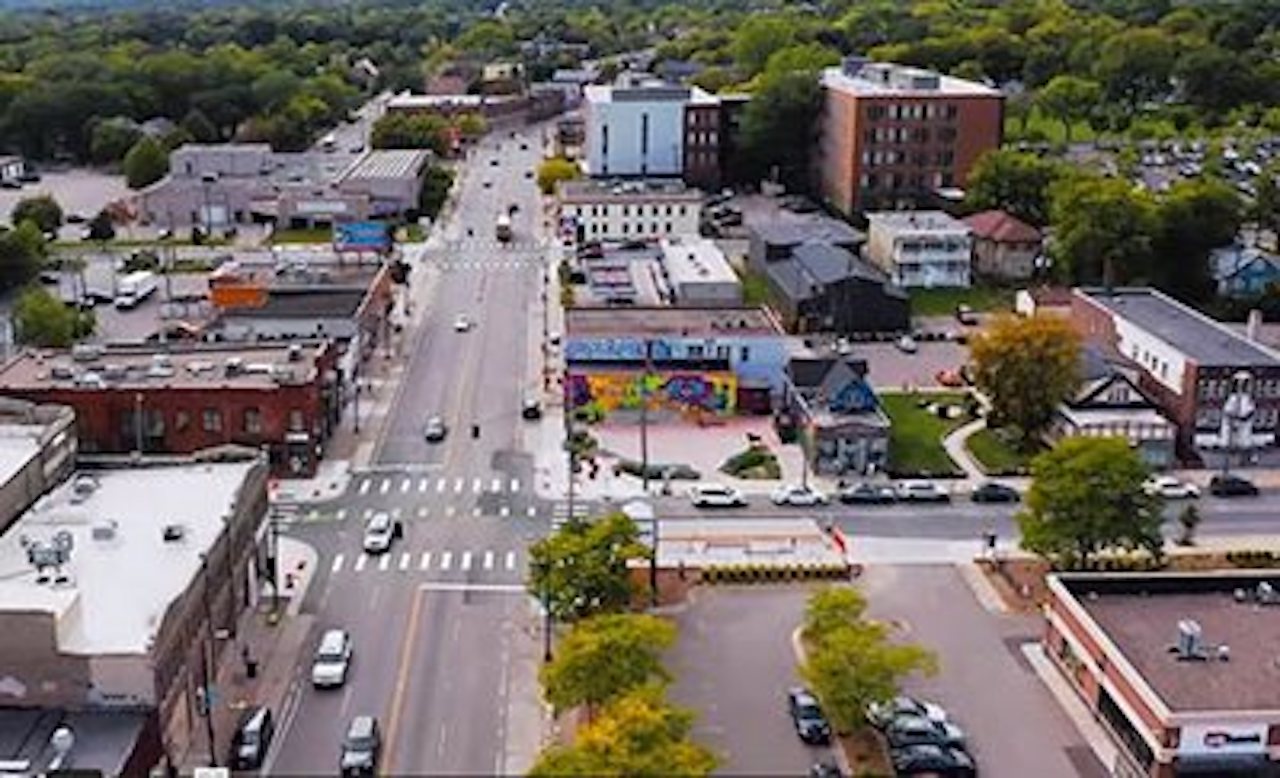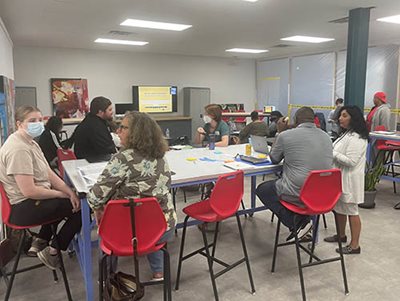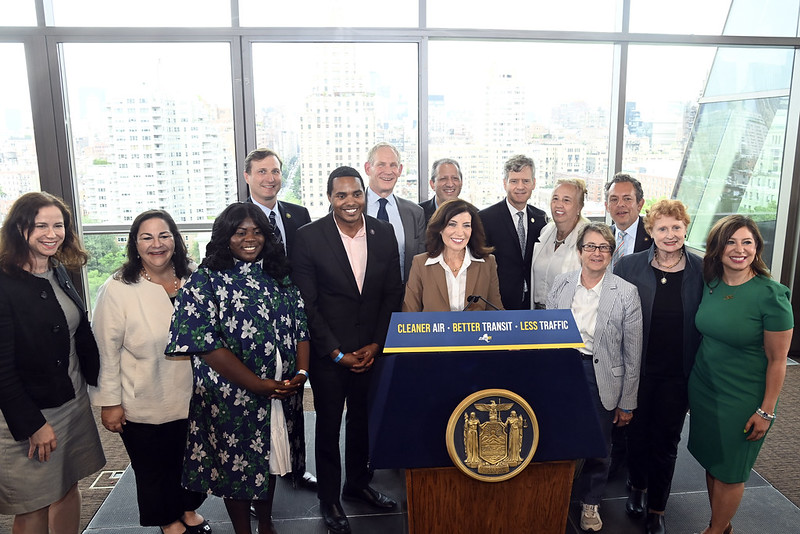
Transit Briefs: Minn. Met Council, NJ Transit, SEPTA, NTMTA, Calif. State Budget
Written by Carolina Worrell, Senior Editor
Aerial photo of a portion of West Broadway Avenue in north Minneapolis, the proposed route of the Blue Line light rail extension. (Met Council)
The Minnesota Metropolitan (Met) Council’s Anti-Displacement Working Group makes recommendations on Blue Line Extension. Also, NJ Transit launches customer awareness campaign to promote kindness; the Southeastern Pennsylvania Transportation Authority (SEPTA) launches its Open Data Portal; the New York Metropolitan Transportation Authority (MTA)’s congestion pricing plan wins federal approval after comprehensive environmental review; and California Gov. Gavin Newsom and state lawmakers reach a deal on the 2023-2024 budget that includes $5.1 billion for transit capital funding.
Minn. Met Council
Minnesota’s Met Council announced June 27 that it is taking public engagement on the Blue Line light rail extension project to a new level to ensure it gains a “deep understanding of community needs, opportunities and the impact of the project.” The goal, Met Council says, is to “ensure residents and businesses currently along the route are the ones to benefit from this transformative transit investment.”
A year and a half ago, the Met Council and Hennepin County asked the University of Minnesota’s Center for Urban and Regional Affairs (CURA) to facilitate a working group of neighborhood residents, businesses, city representatives, community, organizations and nonprofits in the corridor. Eighteen months of group discussions, community meetings and one-on-one outreach has resulted in a detailed roadmap to help the region “navigate the human side of building a light rail route.”

Met Council officials agree with the CURA report, Blue Line Extension Anti-Displacement Recommendations, that the line will only be a success if it benefits the people who are living and working along the route right now. “The line should be an engine of opportunity for people who are living there today, instead of a catalyst for displacement,” said Met Council Chair Charlie Zelle.
Connecting the Region to a Culturally Rich Corridor
The proposed route will serve the northwest metro, including neighborhoods from downtown Minneapolis, the Northside, to Robbinsdale, Crystal, and Brooklyn Park. Neighborhoods throughout the corridor are home to many local businesses, nonprofits, and community organizations that invest in housing, arts, small businesses, and youth programming. The line will serve key cultural and commercial destinations like the West Broadway corridor in North Minneapolis and Robbinsdale’s historic downtown area, opening opportunities to connect more customers and people to vibrant areas along the line.
The Blue Line Extension project is in the design and engineering phase. While a general preferred route has been selected, Met Council says many important decisions remain, including route options between Target Field Station and West Broadway or 21st Avenue North. Specific station locations and even track placements still must be worked out, too. Hundreds of decisions need to be made, and they will all need the input and advice from the people the line will serve.
What’s at Stake As the Light Rail Line is Built
According to Met Council, “there is no question the proposed line will bring significant investment and economic growth. But many residents wonder who will benefit.” This Blue Line extension route has many small, neighborhood businesses and naturally occurring affordable housing that are all part of a vibrant, unique community.
The 17 desired outcomes listed in the report would ensure that business owners “can stay in business, residents can still afford their rent, rising property taxes don’t force homeowners to sell, public infrastructure and other amenities are improved, and that rich culture of the communities served are further enriched by the presence of the light rail line.”
Moving the Recommendations Forward
The CURA report makes specific recommendations for each city along the line. While many of the ideas and approaches have been used to plan and build past transit routes, they have never been incorporated at the recommended scale. One of the key points made by CURA is that no single entity can do this work.
That point is being taken seriously by the Blue Line’s Corridor Management Committee, which includes representatives from the Met Council, Hennepin County, all the cities the line will serve, along with business and community leaders. This month, the committee passed a resolution to create a framework and public engagement plan to carry this work to the next level. It will include extensive public engagement with community members, public, nonprofit, and philanthropic organizations, and business members.
“This is an important next step,” said Zelle, who chairs the committee. “We can only move at the speed of trust.”
More information on the report is available here.
NJ Transit
NJ Transit on June 27 unveiled an informational campaign called “RIDE KIND” designed to “remind and encourage customers to treat all their fellow customers and NJ Transit employee with kindness and respect.”
NJ Transit President and CEO Kevin S. Corbett was joined at Newark Penn Station on Tuesday by representatives of the agency’s unions, representing frontline bus operators and rail crews to launch the initiative. During the campaign, customers will see messaging, including posters and signs on board buses and trains, inside stations and on social media to encourage customers and employees to model ideal transit behaviors. NJ Transit staff will also hold occasional pop-up events to “promote, recognize and reward acts of kindness across the system.”

“RIDE KIND is an excellent way to remind all of our customers to treat everyone on the transit system with respect, both fellow customers and our employees,” said New Jersey Department of Transportation (NJDOT) Commissioner and NJ Transit Board Chair Diane Gutierrez-Scaccetti. “If everyone does their part, we can ensure a safe and pleasant experience.”
“It is critical for everyone to show kindness and respect when riding the transit system,” said NJ TRANSIT Board member Rashonda Brown. “A little kindness can go a long way in keeping the system safe and inviting for all.”
“RIDE KIND isn’t just a slogan—it’s a call to action for everyone who rides NJ Transit,” said Corbett. “We want it to serve as a reminder that kindness and respect are basic fundamentals for a safe and comfortable mass transit experience.”
“We’ve seen in the news assaults of transportation workers are on the rise,” said General Chairman & President of SMART-TD Local 60 Jerome Johnson. “We hope this initiative serves as a good reminder to the public and helps further protect the safety and well-being of the hard-working men and women who are essential in our daily lives.”
“Safety for transportation workers must be important to the riding public,” said Amalgamated Transit Union (ATU) Chairman Orlando Riley. “In 2020, we all realized how crucial frontline workers were to the state of New Jersey. They serve our state every day, and we need to continue campaigns like ‘RIDE KIND’ to ensure their safety on the job.”
According to the agency, NJ Transit has made several advancements to enhance customer and employee safety throughout its system and recently received national recognition for its work. For the second time in three years, NJ Transit was presented the American Public Transportation Association (APTA) Bus Safety and Security Excellence Gold Award in April 2023. NJ Transit was awarded the 2023 Gold Award for its De-Escalation/Operator Assault training program for front-line bus employees that helps them manage difficult situations and minimize the potential for employee assaults. Similar training is also being provided to NJ Transit’s Rail Operations employees.
NJ Transit has also taken steps to strengthen protection for transit workers. In January 2022, Governor Murphy signed the Motorbus and Passenger Rail Service Employee Violence Prevention Act (S4701) to create new tools for protecting transit workers throughout the state. In addition to upgrading the penalty for all assaults on a motorbus operator or a member of a rail crew, the law also authorizes NJ Transit and other public transit carriers to suspend or prohibit from ridership individuals who commit assaults against employees or otherwise jeopardize the safety and well-being of the riding public.
In 2023, a Superior Court Judge granted NJ Transit’s request to suspend for a period of one year the riding privileges of an individual who had been charged with at least seven separate lewd acts aboard NJ Transit buses in the past two years.
The NJ Transit Board of Directors has also approved a plan to begin the rule-making process to administratively suspend ridership privileges for individuals who assault transit employees. Those rules are currently being finalized and will be presented to the Board of Directors for final adoption.
NJ Transit operators are protected employees under the laws of the State of New Jersey. An assault on NJ Transit bus operators and train crews carries the possibility of a prison term of up to 5 years and fines up to $15,000.
SEPTA
SEPTA on June 27 announced that its Open Data Portal—a catalog of financial, ridership, mapping and other useful data—is now available on the agency’s website.
The portal features the new Ridership Recovery Dashboard, which shows the ridership and service levels for all of SEPTA’s modes relative to their pre-pandemic baselines.
“We are excited to share this valuable tool with our employees, riders, and community partners,” said SEPTA General Manager and CEO Leslie S. Richards. “This new portal will help foster transparency, accountability, and build trust with the communities we serve.”
The Open Data Portal supports SEPTA Forward, the Authority’s strategic plan by making data publicly available to “unleash the potential for innovative ideas and solutions from across the region,” the agency said.
SEPTA says it is committed to growing the catalog of data over time and welcomes feedback from the public.
The Open Data Portal can be found here. The Ridership Recovery Dashboard can be found here.
NYMTA
The MTA on June 27 announced that the Federal Highway Administration (FHWA) has completed the environmental review of New York State’s congestion pricing program—Manhattan Central Business District Tolling—following a 30-day public availability period of the Final Environmental Assessment (EA).
FHWA issued a Finding of No Significant Impact (FONSI), confirming the conclusion of the EA, which includes mitigation measures to be undertaken by the program, that the program will have “no significant environmental impacts.”
The EA, prepared by the Triborough Bridge and Tunnel Authority (TBTA), an affiliate agency of MTA, New York State Department of Transportation (NYSDOT), and New York City Department of Transportation (NYCDOT), in consultation with FHWA, found the program is “expected to meet its objectives by reducing congestion and overall vehicle miles traveled, with related regional air quality benefits, while providing financial support to capital upgrades for the MTA’s public transportation system.”
According to MTA, before a tolling rate structure can be set, the Traffic Mobility Review Board (TMRB), a body required by the April 2019 State Legislation that established the Central Business District Tolling Program, will develop a recommended toll structure after considering factors, such as traffic patterns, traffic mitigation measures, operating costs, public impact, public safety, vehicle types, discounts, peak and off-peak rates, air quality and emissions trends. The TMRB will provide a report explaining its recommendations, including the underlying review and analysis, to the Board of TBTA, which is coterminous with the MTA Board. The TBTA Board will adopt and establish the tolling structure.
If a tolling structure is adopted on a timeline as expected, MTA says a toll collection could begin as early as May 2024, which gives contractors a contractually obligated 310 days to finish designing, developing, testing, and installing the tolling system and equipment.
According to MTA, the assessment finds that across the 28-county area studied in the environmental review, of those who commute to work in Manhattan’s Central Business District (CBD), only 11% drive and 85% use public transportation. “By reducing congestion and creating revenue for public transportation, the program will benefit millions of people every day. Through a package of mitigation measures, the program will also improve air quality in environmental justice communities,” MTA said.
The program, MTA adds, will generate net revenues sufficient to leverage $15 billion for the agency’s 2020-2024 Capital Program, which includes transformational projects. The MTA’s transit system, and particularly the bus network, promotes equity by serving low-income and minority populations. The funding, the agency says, will allow the MTA “to progress on its aggressive timeline of completing accessibility improvements, along with performing necessary state-of-good repair work to the more-than-a-century old transit system.”

According to a New York Daily News report, the congestion pricing plan has been in the works since 2019, when state legislature passed a law instituting the tolls to fund the MTA’s capital budget.
Advocates have said of the plan, which will charge drivers for entering Manhattan at 60th Street or below, will also “shift would-be drivers onto the region’s mass transit, as similar policies have in London and Stockholm,” according to the report.
According to the New York Daily News report, Gov. Kathy Hochul “praised the federal government’s decision to green-light New York’s congestion pricing plan Tuesday, saying the policy would dramatically improve quality of life in the city—though many details of the plan remain unclear.”
MTA Chairman and CEO Janno Lieber addressed the crowd during a recent press conference after Hochul.
“We’re always talking about the drivers and what they’re doing and how they’re being impacted,” Lieber said. “Ninety percent of New Yorkers who come to the central business district take mass transit. Let’s think about them for a minute, and what [congestion pricing] is going to do for them.”
More information on the program is available here.
Calif. State Budget
California Gov. Gavin Newsom and state lawmakers announced June 26 that they have reached a deal on the 2023-2024 budget “without touching the state’s safety net,” according to a report by The Hill.
According to the report, the $310.8 billion budget, which would include $225.9 billion in general fund spending, would seek to bridge a nearly $32 billion deficit while maintaining $37.8 billion in reserves.
According to an Assembly Budget Committee floor report, public transit would also receive $5.1 billion for transit capital funding over three years, “restoring a transit and intercity rail program that Newsom had intended to scrap,” The Hill reported.
“We’re also addressing transit’s fiscal cliff [with] $5.1 billion—most of which is flexible for capital and operations,” said Budget Committee Chair Phil Ting, via Twitter.



